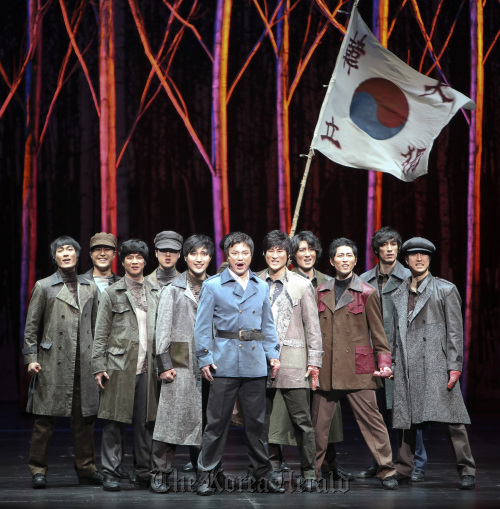NEW YORK (AP) ― Non-Korean-speaking theatergoers attending Lincoln Center’s production of “Hero: The Musical” might find themselves occasionally skipping some of the English supertitles projected high above the stage to devote more visual attention to the exorbitant onstage attractions in this lavish, $6 million production.
It would be understandable considering the elaborate set and ornate costumes that adorn the sweeping, historical tribute to Korean nationalism ― a somber, grueling epic that is as ambitious as it is long.

The cast of the Korean musical, “Hero: The Musical,” performs in New York. (AP-Yonhap News)
“Hero” tells the story of An Chunggun (played by Sung Hwa Chung), a leader of Korea’s armed resistance against Japanese rule in the early 1900s. An was executed for the assassination of Ito Hirobumi (Sung Gee Kim), the Japanese administer of power in Korea.
The musical was commissioned to commemorate the 100th anniversary of An’s death and was widely acclaimed in Korea before making its American debut Tuesday at Lincoln Center’s David H. Koch Theater.
Its mostly grim, reflective score ― with music by Sang Joon Oh and book and lyrics by A Reum Han ― includes more than 30 numbers that are presented and orchestrated in a style similar to a typical American musical.
Many of the songs are somewhat staid ballads about patriotism and sacrifice, generally lacking the kind of tunefulness that sends audiences away humming.
But “Hero” seems to hang its hat on the scale of its production as much as anything else.
The spectacle runs nearly three hours, including one intermission, and boasts dozens of performers in brilliant, traditional attire, as well as a movable, layered set featuring bold splashes of color and transparencies.
The costumes are consistently appealing, from the radiant kimonos of fan-waving Geishas to the stunning regalia of sword-wielding soldiers.
The creative vision also includes an overabundance of artificial smoke, dynamic lighting and generous use of video projection that contributes motion and depth, with effects varying from spellbinding to dizzying.
In one of the show’s more stirring dance numbers, Japanese police chase Korean freedom fighters through streets and across scaffolds, as projections of brick tenements illuminate sliding backdrops to simulate a captivating 3-D effect.
Under the direction of Ho Jin Yun, the violent clashes between Koreans and Japanese are artfully expressed in balletic brawls reminiscent of Sharks vs. Jets.
The most impressive set in “Hero” might be its most disorienting as well. The climactic scene occurs aboard a train hurtling through a snowy night. The full exterior of a life-size train is audaciously sprawled across the stage, behind a translucent screen that reflects a frenetic shower of wind-blown snow.
The train’s facade has a cutaway that hauntingly appears and disappears, allowing the audience to intermittently peer inside the car and observe its occupants and lushly decorated interior.
The approach initially results in a strongly alluring, cinematic effect. But as the scene unfolds, the heavy snow becomes a persistent and unnecessary distraction to what’s happening inside the car.
For better or worse, it is the unique visual expression ― and not the music ― that will make people remember “Hero,” which is on display at the Koch Theater through Sept. 3.






